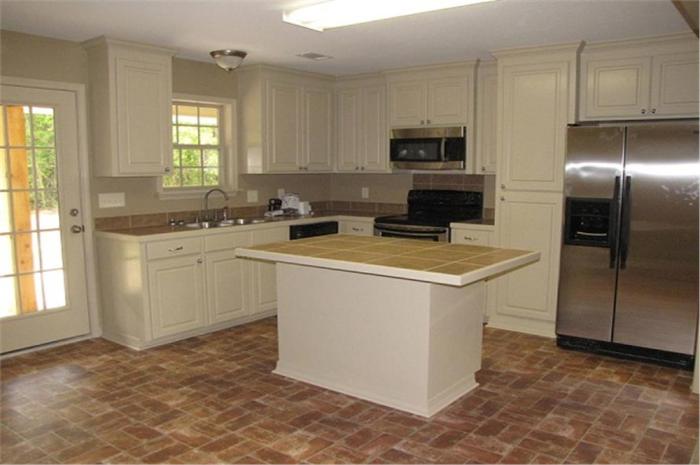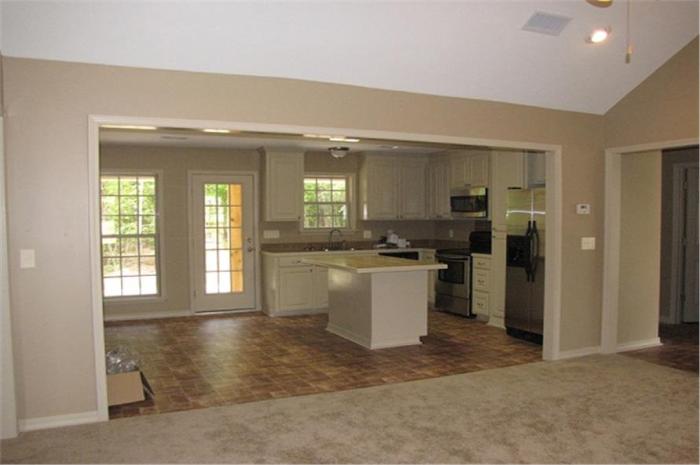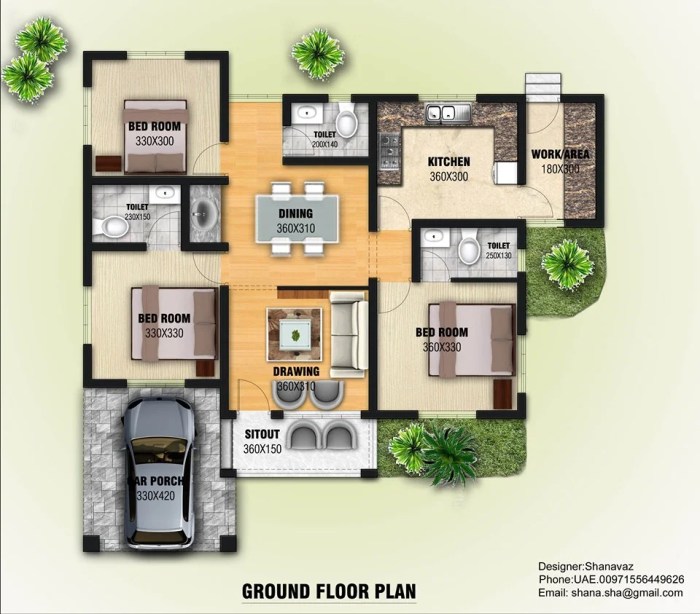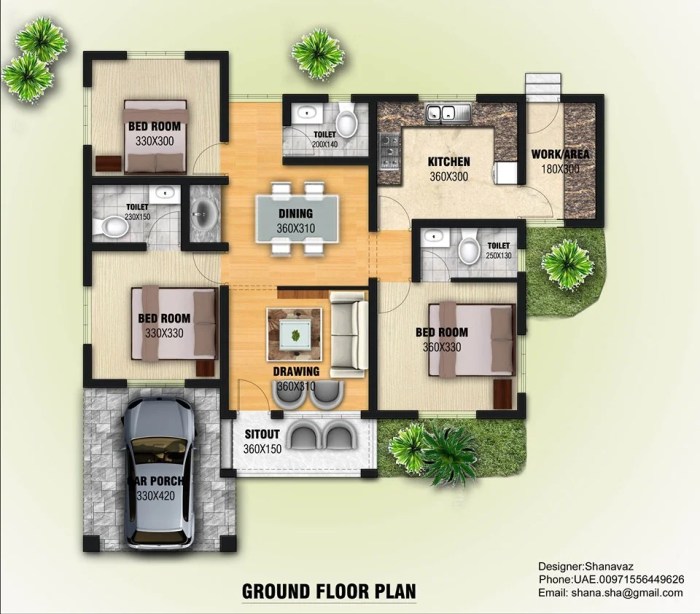1300 square feet house interior design presents a unique challenge: maximizing space and functionality while creating a stylish and inviting atmosphere. With careful planning and design choices, you can transform this modest space into a haven that reflects your personal style and meets your family’s needs.
From choosing a cohesive color palette to selecting furniture that optimizes space, this guide explores the essential steps to designing a 1300 square feet house that feels both spacious and cozy.
This guide covers a range of aspects, from understanding the layout and flow of the house to selecting furniture and decor that complements your chosen style. We’ll delve into maximizing natural light and ventilation, incorporating storage solutions, and creating a welcoming atmosphere with the use of textures, patterns, and personal touches.
By the end, you’ll have a clear understanding of how to transform your 1300 square feet house into a home that is both functional and beautiful.
Understanding the Space: 1300 Square Feet House Interior Design

A 1300 square feet house offers a comfortable living space for a small family or individuals seeking a balanced blend of functionality and style. Understanding the typical layout and potential configurations is crucial for maximizing the potential of this space.
Designing a 1300 square feet house interior can be a challenge, especially when you want to maximize space and create a functional layout. For inspiration, consider the principles used in 1000 square feet house interior design , which often prioritize multi-functional spaces and clever storage solutions.
These concepts can be adapted to a 1300 square feet home, allowing you to create a spacious and inviting atmosphere even with a larger footprint.
Typical Layout and Room Arrangements
The layout of a 1300 square feet house can vary depending on the architectural style and personal preferences. However, common room arrangements often include:
- Living Room:The living room is typically the central hub of the house, providing a welcoming space for relaxation and entertainment.
- Dining Room:A dedicated dining room offers a formal space for meals and gatherings. However, in smaller homes, the dining area may be integrated with the kitchen or living room.
- Kitchen:The kitchen is essential for preparing meals and often features a functional layout with ample counter space and storage.
- Bedrooms:A 1300 square feet house typically accommodates two to three bedrooms, providing comfortable sleeping quarters for family members.
- Bathrooms:One or two bathrooms are standard, ensuring sufficient facilities for the household.
Different Floor Plans
Here are examples of floor plans that can be effectively utilized for a 1300 square feet house:
- Open Concept Floor Plan:This design eliminates walls between the living, dining, and kitchen areas, creating a spacious and airy ambiance. Open floor plans promote a sense of flow and enhance natural light penetration.
- Traditional Floor Plan:This layout features distinct rooms with defined boundaries. Traditional floor plans offer privacy and separation between spaces, creating a more formal atmosphere.
- Split-Level Floor Plan:This design divides the house into different levels, often with the living areas on one level and bedrooms on another. Split-level floor plans can maximize space utilization and offer unique architectural features.
Advantages and Disadvantages of Room Configurations
The choice of room configuration depends on the lifestyle and preferences of the occupants.
- Open Concept:
- Advantages:Creates a sense of spaciousness, enhances natural light, promotes social interaction, and allows for flexible furniture arrangements.
- Disadvantages:May lack privacy, noise can travel easily, and it can be challenging to define distinct areas.
- Traditional:
- Advantages:Offers privacy and separation between spaces, creates a more formal atmosphere, and can be easier to manage noise levels.
- Disadvantages:Can feel smaller and less airy, may limit natural light penetration, and can restrict flexibility in furniture arrangement.
- Split-Level:
- Advantages:Maximizes space utilization, offers unique architectural features, and can provide a sense of separation between living and sleeping areas.
- Disadvantages:May require more stairs, can make the house feel less connected, and may not be suitable for individuals with mobility limitations.
Creating a Flow
A well-designed flow within a 1300 square feet house is crucial for enhancing functionality and creating a sense of harmony. It involves creating a seamless transition between spaces, optimizing traffic patterns, and maximizing natural light and ventilation. This section will explore strategies to achieve a smooth and efficient flow within the home.
Designing a 1300 square foot house allows for more creative freedom and flexibility compared to smaller spaces. However, even in a larger home, maximizing functionality and aesthetics is crucial. For inspiration on maximizing space in smaller homes, you can explore design ideas for a 100 sq ft house interior design.
These techniques, like clever storage solutions and multi-functional furniture, can be adapted to larger homes to enhance the overall design and flow of a 1300 square foot space.
Maximizing Natural Light and Ventilation
Natural light and ventilation play a significant role in creating a comfortable and inviting atmosphere. Optimizing these elements is essential for a 1300 square feet house.
- Strategic Window Placement:Place windows strategically to maximize natural light penetration. Consider the direction of the sun and the desired light levels in each room. South-facing windows offer the most sunlight throughout the day, while east-facing windows provide morning light and west-facing windows offer afternoon light.
- Lightwells:Lightwells are vertical shafts that bring natural light into the interior of a building, especially in areas that lack direct sunlight. This is particularly useful for homes with limited window space or those with interior rooms.
- Skylights:Skylights are a great way to introduce natural light into the interior of a house. They can be placed in various locations, such as the kitchen, living room, or bathroom. However, it’s important to consider the potential for heat gain during the summer months.
- Cross Ventilation:Cross ventilation is the process of using multiple windows to create a flow of air through a space. This helps to improve air circulation and reduce the need for artificial ventilation.
- Open Floor Plans:Open floor plans promote natural light and ventilation by allowing light to flow freely between rooms. They also create a sense of spaciousness.
Space Utilization Optimization
In a 1300 square feet house, maximizing space utilization is essential. Here are some creative solutions to optimize space in a smaller home:
- Multi-Functional Furniture:Invest in furniture that serves multiple purposes, such as a sofa bed, a coffee table with storage, or a dining table that can be extended.
- Vertical Storage:Maximize vertical space by utilizing shelves, wall-mounted organizers, and cabinets. This helps to keep belongings organized and out of sight.
- Built-in Storage:Built-in storage solutions, such as cabinets, shelves, and drawers, can be customized to fit the specific needs of each room.
- Mirrors:Mirrors can create the illusion of space by reflecting light and making a room appear larger.
- Light Colors:Light colors on walls and furniture can make a room feel more spacious and airy.
Choosing a Style

The style you choose for your 1300 square feet house will greatly influence the overall look and feel of your home. There are numerous interior design styles to choose from, each with its own unique characteristics and advantages. Here are three popular styles to consider: contemporary, traditional, and eclectic.
Contemporary Style
Contemporary style is characterized by clean lines, minimalist furniture, and a focus on functionality. It often incorporates natural materials such as wood, stone, and metal. This style is known for its spacious and airy feel, making it a good choice for smaller homes.
- Key Features:
- Clean lines and geometric shapes
- Neutral color palettes with pops of color
- Minimalist furniture with simple designs
- Natural materials like wood, stone, and metal
- Open floor plans
- Advantages:
- Creates a spacious and airy feel
- Easy to maintain
- Versatile and adaptable to different lifestyles
- Disadvantages:
- Can feel cold or sterile if not balanced with warm elements
- May not be suitable for those who prefer a more traditional or ornate style
Traditional Style, 1300 square feet house interior design
Traditional style is characterized by its classic and timeless elegance. It often features ornate furniture, rich fabrics, and warm color palettes. This style is known for its cozy and inviting feel, making it a good choice for families and those who appreciate a more formal aesthetic.
- Key Features:
- Curved lines and ornate details
- Warm color palettes with rich tones
- Elaborate furniture with intricate carvings
- Patterned fabrics and textiles
- Use of antiques and heirloom pieces
- Advantages:
- Creates a cozy and inviting atmosphere
- Timeless and elegant
- Suitable for families and those who appreciate a formal aesthetic
- Disadvantages:
- Can feel cluttered or overwhelming in smaller spaces
- May be more expensive to decorate
Eclectic Style
Eclectic style is a mix of different styles and influences. It allows you to incorporate your favorite pieces and create a unique and personalized look. This style is known for its bold and expressive nature, making it a good choice for those who enjoy a diverse and interesting aesthetic.
- Key Features:
- Combination of different styles and influences
- Bold use of color and pattern
- Unique and interesting furniture pieces
- Mix of textures and materials
- Personal and expressive style
- Advantages:
- Allows for a unique and personalized look
- Can be adapted to any space
- Encourages creativity and individuality
- Disadvantages:
- Can be challenging to pull off without a cohesive vision
- May feel cluttered or overwhelming if not curated carefully
Color Palette and Materials
The color palette and materials chosen for a 1300 square foot house interior design will significantly influence the overall ambiance and functionality of the space. It is essential to create a cohesive and visually appealing design that complements the chosen style while maximizing the sense of space.
Color Palette
A well-chosen color palette can enhance the feeling of spaciousness and create a harmonious flow throughout the home. For a 1300 square foot house, a light and airy color palette is generally recommended. Light colors, such as whites, creams, and pastels, reflect light and make the space appear larger.
For example, using a neutral base like white or cream on the walls can create a clean and spacious backdrop for furniture and décor. Accents of color can be introduced through furniture upholstery, artwork, and throw pillows.
Material Selection
The choice of materials for furniture and décor is crucial for creating a cohesive and functional interior design. Natural materials, such as wood, stone, and textiles, can bring warmth and texture to a space. For example, wooden furniture pieces can add a touch of warmth and sophistication, while stone countertops can provide a durable and elegant surface.
Textiles, such as linen, cotton, and wool, can be used for upholstery, curtains, and rugs, adding softness and comfort to the home.
Designing a 1300 square feet house can be a challenge, especially when trying to maximize space and functionality. You might find inspiration from the principles of 100 sqm house interior design , which often emphasizes clever storage solutions and multi-purpose furniture.
By adapting these ideas to your larger space, you can create a home that feels both spacious and well-organized, even in a 1300 square feet house.
Color Combinations and Material Pairings
Here is a table showcasing examples of color combinations and material pairings for different design styles:| Design Style | Color Palette | Material Pairings ||—|—|—|| Modern| White, gray, black, metallic accents | Wood, metal, glass, leather || Contemporary| Neutral tones with pops of color | Wood, metal, concrete, textiles || Scandinavian| White, gray, beige, natural wood | Wood, wool, linen, cotton || Bohemian| Earthy tones, vibrant colors, patterns | Wood, textiles, metal, ceramics || Coastal| Blue, green, white, natural wood | Wood, rattan, linen, cotton |
Furniture Selection
Furniture selection is a crucial part of interior design. Choosing the right pieces can transform a house into a stylish and comfortable home. This section will explore the process of selecting furniture for a 1300 square feet house, focusing on functionality, style, and space optimization.
Essential Furniture Pieces
A 1300 square feet house requires a balanced selection of furniture to ensure both functionality and aesthetic appeal. Here is a list of essential furniture pieces to consider:
- Living Room:A sofa, armchairs, coffee table, end tables, TV stand, and possibly a media console or bookcase.
- Dining Room:A dining table and chairs, a buffet or sideboard for storage.
- Bedrooms:A bed, nightstands, a dresser, and possibly a desk or vanity.
- Kitchen:A kitchen island, bar stools, and possibly a breakfast table.
- Bathrooms:A vanity with a mirror, a toilet, and a shower or bathtub.
- Entryway:A console table, a mirror, and a coat rack.
Choosing Stylish and Comfortable Furniture
The ideal furniture combines style and comfort. Here are some tips for achieving this balance:
- Consider the Style:Select furniture that complements the overall style of your house. For example, a mid-century modern house might benefit from furniture with clean lines and geometric shapes, while a farmhouse style home might favor rustic wood and distressed finishes.
- Prioritize Comfort:Choose furniture that feels comfortable to sit or sleep on. Consider the firmness of the sofa cushions, the height of the chairs, and the quality of the mattress.
- Look for Versatile Pieces:Opt for furniture that can serve multiple purposes. For example, a sofa bed can provide additional sleeping space for guests, while a storage ottoman can offer extra seating and storage space.
Optimizing Space
Furniture selection plays a significant role in optimizing space in a 1300 square feet house. Here are some tips for maximizing space:
- Measure Your Space:Before buying any furniture, measure the area where you plan to place it. This will help you avoid purchasing pieces that are too large or too small for the space.
- Use Multifunctional Furniture:As mentioned earlier, opting for pieces that serve multiple purposes can save space. For example, a coffee table with built-in storage can eliminate the need for a separate storage unit.
- Embrace Vertical Space:Utilize vertical space by incorporating tall bookshelves, cabinets, or wall-mounted shelves. This can free up floor space and create a more spacious feel.
- Consider Furniture Placement:The placement of furniture can significantly impact the flow and feel of a space. Arrange furniture in a way that maximizes walking space and allows for easy movement throughout the house.
Selecting Furniture That Scales Appropriately
Furniture should be scaled appropriately to the size of the house. Here are some considerations:
- Avoid Overcrowding:Don’t fill the space with too much furniture. Leave enough space for people to move around comfortably. A good rule of thumb is to leave at least 3 feet of walking space between furniture pieces.
- Choose Pieces That Fit the Proportions:Select furniture that is proportional to the size of the room. For example, a small sofa might look lost in a large living room, while a massive armoire might overwhelm a small bedroom.
- Consider the Ceiling Height:Furniture should be scaled to the ceiling height. For example, tall furniture can make a room feel more spacious, while low furniture can create a cozy atmosphere.
Lighting and Accessories
Lighting is an essential element in interior design, as it can significantly impact the mood, functionality, and overall aesthetics of a space. A well-designed lighting plan creates a welcoming and comfortable atmosphere, highlighting key features and enhancing the beauty of your 1300 square feet home.
Lighting Plan for Different Areas
A comprehensive lighting plan considers the specific needs of each area within the house. It involves using a combination of ambient, task, and accent lighting to achieve a balanced and functional illumination.
- Living Room:A combination of ambient lighting from a central chandelier or ceiling fixture, task lighting for reading or working, and accent lighting to highlight artwork or architectural features.
- Dining Room:A statement pendant light over the dining table provides a focal point and illuminates the dining area. Accent lighting can be used to highlight the table centerpiece or create a warm ambiance.
- Kitchen:Task lighting is crucial for food preparation and cleaning. Under-cabinet lighting illuminates countertops, while pendant lights over the island provide general illumination. Ambient lighting can be achieved with recessed ceiling lights or a stylish chandelier.
- Bedroom:A combination of ambient lighting from a ceiling fixture, bedside lamps for reading, and accent lighting for decorative elements like artwork or a vanity mirror.
- Bathroom:Vanity lighting is essential for applying makeup or shaving. Recessed ceiling lights provide general illumination, while a small pendant light over the tub can create a relaxing ambiance.
Types of Lighting Fixtures
A variety of lighting fixtures can be used to create a visually appealing and functional lighting plan.
- Pendant Lights:Hanging from the ceiling, pendant lights offer a stylish and decorative element while providing ample illumination. They are ideal for dining rooms, kitchens, and entryways.
- Sconces:Wall-mounted sconces offer a versatile and decorative lighting solution. They can be used in hallways, bedrooms, and living rooms to provide ambient or accent lighting.
- Floor Lamps:Floor lamps are a great way to add a touch of style and provide additional illumination. They are ideal for living rooms, bedrooms, and reading nooks.
- Recessed Lights:Recessed lights are discreetly installed in the ceiling, providing even and unobtrusive illumination. They are commonly used in kitchens, bathrooms, and hallways.
- Track Lighting:Track lighting offers flexibility in directing light to specific areas. It is ideal for showcasing artwork, highlighting architectural features, or providing task lighting in kitchens or home offices.
Decorative Accessories
Accessories play a crucial role in adding personality and visual interest to your home. They can enhance the overall style and create a cohesive design.
- Throw Pillows:Adding texture and color to your sofas, beds, and chairs, throw pillows create a cozy and inviting ambiance.
- Rugs:Rugs define spaces, add warmth, and enhance the visual appeal of your floors. Choose rugs that complement your furniture and color scheme.
- Artwork:Artwork can be a focal point in your home, adding personality and visual interest. Choose pieces that reflect your taste and complement the overall design.
- Vases and Plants:Vases filled with fresh or artificial flowers add a touch of color and life to your home. Plants purify the air and bring a touch of nature indoors.
- Candles and Holders:Candles create a warm and inviting atmosphere. Choose candles and holders that complement your decor and add a touch of elegance.
- Mirrors:Mirrors reflect light, making spaces feel larger and brighter. They can also be used to create a focal point or enhance the visual appeal of a room.
- Bookshelves and Books:Bookshelves add a touch of sophistication and can be used to display books, decorative items, or family photos.
- Sculptures and Figurines:Sculptures and figurines can add a touch of personality and style to your home. Choose pieces that reflect your taste and complement your decor.
Final Wrap-Up

Designing a 1300 square feet house interior is a rewarding journey that involves balancing functionality, style, and personal preferences. With careful planning, a thoughtful approach to space utilization, and an understanding of your needs and desires, you can create a home that feels both spacious and inviting.
By incorporating the tips and insights presented in this guide, you can transform your 1300 square feet house into a haven that reflects your unique personality and enhances your everyday life.
Frequently Asked Questions
What are some common layout options for a 1300 square feet house?
Common layouts for a 1300 square feet house often include a 3-bedroom, 2-bathroom design, with a living room, dining area, and kitchen. Some variations may include a separate family room or a den, depending on the specific floor plan.
How can I make a small living room feel more spacious?
Use light colors on the walls, incorporate mirrors to reflect light, and choose furniture with clean lines and minimal bulk. Opt for multi-functional furniture like a sofa bed or a coffee table with storage space.
What are some budget-friendly ways to update my kitchen?
Refresh your kitchen cabinets with a coat of paint, replace cabinet hardware, and update the backsplash with affordable tile options. Adding new lighting fixtures can also make a significant impact.
How can I create a cohesive style throughout my house?
Choose a color palette that flows throughout the house, incorporating accent colors in different rooms. Use similar materials and finishes for furniture and decor to create a sense of continuity.

